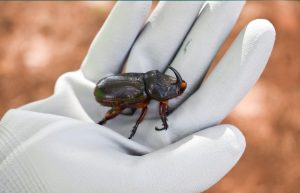Researchers across the world are looking for some kind of bug or disease that can control the coconut rhinoceros beetle, (CRB).
Beetle infestations elsewhere were controlled a few decades ago with the release of a biocontrol virus called Oryctes rhinoceros nudivirus. But in Hawai’i we have a new strain of CRB that seems to be resistant to that virus.
Hawai’i’s biotype of the beetle, also found in Guam and some other Pacific areas, is called CRB-G (clade 1.)
As scientists scramble to look for predators, parasites or disease that might help, research is now focusing on a fungus called Metarhizium, which, when it is effective, kills the CRB beetle larvae and then covers the beetle larva with white fuzzy hairs that later turn green.
There is still more work to be done, but “biopesticides containing Metarhizium spp. are the strongest candidates for inundative biological control against the emerging CRB threat,” said this paper, which will be published in the November 2024 issue of the journal Fungal Biology.

(Adult CRB, image courtesy Hawaii Department of Agriculture)
That work is being done by researchers from Papua New Guinea, the Solomon Islands, Colombia, and New Zealand, and was funded by the New Zealand Ministry of Foreign Affairs and Trade. The lead author of that paper is biocontrol researcher Laura Villamizar of AgResearch Ltd. in New Zealand.
One particular isolate of one species of the fungus, Metarhizium majus, appeared to kill CRB (S and G haplotypes) larvae within three to four weeks of application.
“Under field conditions, this isolate demonstrated its ability to infect CRB, dispersal up to 100 m from treated artificial breeding sites, and persistence in soil for at least four months,” the authors said.
That’s all good, but it is early research, and before a biocontrol can be released into a new environment, work needs to be done on what the unwanted impacts might be…like, does this fungus also attack the larvae of valued pollinating insects?

(Larval CRB, image courtesy Hawaii Department of Agriculture)
Meanwhile, we are approaching the infestation with conventional means.
This giant horned beetle is devastating Hawaiian coconut palms and threatens many other species. Entire coastal palm landscapes on O’ahu, where the beetle was first spotted in 2013, have been destroyed. The creature is actively spreading on other islands, having been identified on Kaua’i, Maui and Hawai’i islands.
The website of Coconut Rhinoceros Beetle Response has extensive information on the threat.
The beetle is known commonly as CRB, and science calls it Oryctes rhinoceros. The armored adult is up to two inches long and bores into the hearts of palms to feed on their forming leaves. The beetle larvae are the size of your thumb, and feed on decomposing plant debris—characteristically in compost and debris piles.
In addition to coconuts, they will go after other palms, including the threatened native loulu fan palms, as well as bananas, hala, kalo and sugar cane. Even some hardwood trees have been targeted.
Infected coconut palms are easily recognized by the jagged vee-shaped cuts in their fronds, caused by the feeding beetles when the fronds are still forming.

(Adult CRB. Note the horn. For more info see https://dlnr.hawaii.gov/hisc/info/invasive-species-profiles/coconut-rhinoceros-beetle/. Image courtesy Hawaii Invasive Species Council.)
Control measures have include putting netting around the palms to block beetle entrance, and using insecticides. But for many palms and in many environments, neither is a feasible solution. (Some of the palms are too tall to realistically treat.) Furthermore, some insecticides can render the coconuts inedible.
Using attractants like pheromones in traps has been another approach. Here is a paper on the pheromone research done on the beetles. https://www.sciencedirect.com/science/article/pii/S0261219423002235
You will see pheromone-infused hanging insect traps at various locations around the affected islands.
Here’s a trap system folks have used in Guam. https://www.youtube.com/watch?v=47ZQddcvFHk
There is a product called Palm Tree Weevil Killer, PTWK, which claims to be a non-toxic treatment that will kill beetles in the tree. We have not seen independent tests of this system and how well it works. Here are a couple of links: Link 1, Link 2. https://www.hawaiipalmguard.com/uploads/b/58101110-0675-11ef-8f26-0d8569411a43/d9f82fe0-1094-11ef-b96b-3ffeb1dc7cd9.pdf
https://www.alohatreesavers.com/our-product
© Jan TenBruggencate 2024
No comments:
Post a Comment